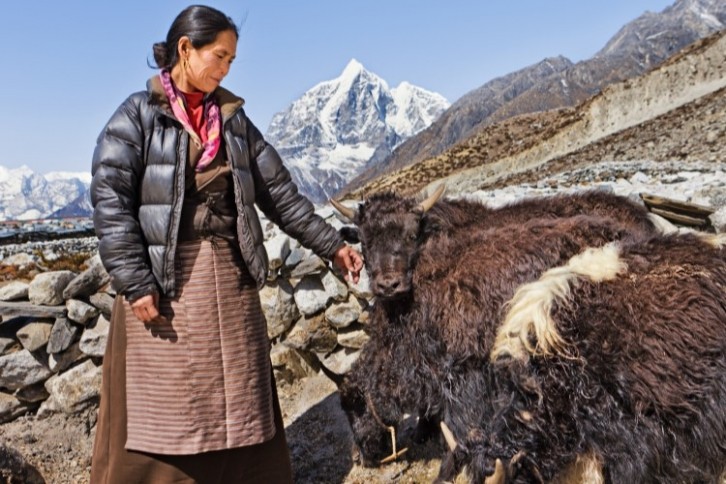Milking the yak: Exploring unconventional milk types and their applications

Yak
The majority of domesticated yaks inhabit cold, dry, high-altitude areas in the Qinghai-Tibet Plateau and provide meat, milk, fur and manure for land fertilization. According to an academic overview into yaks, the animals are often crossbred with cattle to produce a hybrid species for higher milk production.
Yak milk has a higher fat, protein and lactose content than bovine milk but can only be obtained at low volumes of around 150-500kg per lactation, making it unsuitable for industrial scale-up. Limited forage and seasonal breeding are other barriers to large-scale production.
Despite this, yak milk products, both fresh and long-life, are sold in China. In 2020, a co-operative formed in the Qinghai-Tibet Plateau region produced yogurt, meat, ice cream and other dairy products.
Mare
Known informally as horse milk, mare’s milk is clearer, whiter and sweeter than cow’s milk. The composition of mare’s milk is also different – it’s lower in fat, protein content and calories and higher in lactose than cow’s milk. In terms of proteins, studies have found mare’s milk has higher concentrations of whey than cow’s milk.
Mare’s milk products span across beauty, nutrition and food, including fresh and powdered milk, shampoos and creams, and supplements.
A recent study also found that mare’s milk is a viable alternative in yogurt ice cream and synbiotic ice cream production thanks to its functionality and ability to be good carrier for probiotic bacteria.
Camel
Perhaps the least ‘unconventional’ from the bunch, camel milk is a traditional food in the Middle East, Africa and Mongolia. According to United Nations data, camels contribute around 8% of the total milk production in Sub-Saharan Africa. According to Mintel, interest in camel milk is increasing, in part thanks to climate change – camels are more resilient in harsh climate conditions than dairy cows and also bolster superior feeding efficiency.
According to a study published in Nature, increasing the number of camels used for milk production whilst decreasing the dairy cattle herd could increase milk production, lower water and feed use and lower dairy emissions.
As for the milk itself, research has found it has antioxidant and antimicrobial properties and contains substances such as lactoferrin, zinc and mono- and polyunsaturated fatty acids that can help treat diseases like asthma and jaundice. Camel’s whey protein also has a high nutritional value as it’s composed of several soluble proteins but also indigenous proteases, giving it chemical, functional and physiological benefits.
Camel milk’s composition can vary significantly when compared to cow’s milk, research has found. Factors such as feed, seasonality, breed and lactation stage can all influence milk composition.
Camel milk applications vary from dried milk powder to fresh and UHT milk and ice cream. From Dubai-based Camelicious to India dairy co-operative Amul, there are several regional players that offer such products. In Europe, Netherlands-based Camel Dairy Smits claims to be the only camel dairy on the continent. Its milk is also exported to the UK, Belgium, Germany, Austria and Sweden.
Sources:
Kalwar Q, Ma X, Xi B, Korejo RA, Bhuptani DK, Chu M, Yan P. Yak milk and its health benefits: a comprehensive review. Front Vet Sci. 2023 Jun 28;10:1213039. doi: 10.3389/fvets.2023.1213039. PMID: 37456962; PMCID: PMC10338857.
Musaev A, Sadykova S, Anambayeva A, Saizhanova M, Balkanay G, Kolbaev M. Mare's Milk: Composition, Properties, and Application in Medicine. Arch Razi Inst. 2021 Oct 31;76(4):1125-1135. doi: 10.22092/ari.2021.355834.1725. PMID: 35096348; PMCID: PMC8790991.
Szkolnicka K, Mituniewicz-Małek A, Dmytrów I, Bogusławska-Wąs E. The use of mare's milk for yogurt ice cream and synbiotic ice cream production. PLoS One. 2024 Aug 7;19(8):e0304692. doi: 10.1371/journal.pone.0304692. PMID: 39110654; PMCID: PMC11305560.
Rahimi, J., Fillol, E., Mutua, J.Y. et al. A shift from cattle to camel and goat farming can sustain milk production with lower inputs and emissions in north sub-Saharan Africa’s drylands. Nat Food 3, 523–531 (2022). https://doi.org/10.1038/s43016-022-00543-6
Swelum AA, El-Saadony MT, Abdo M, Ombarak RA, Hussein EOS, Suliman G, Alhimaidi AR, Ammari AA, Ba-Awadh H, Taha AE, El-Tarabily KA, Abd El-Hack ME. Nutritional, antimicrobial and medicinal properties of Camel's milk: A review. Saudi J Biol Sci. 2021 May;28(5):3126-3136. doi: 10.1016/j.sjbs.2021.02.057. Epub 2021 Feb 21. PMID: 34025186; PMCID: PMC8117040.














